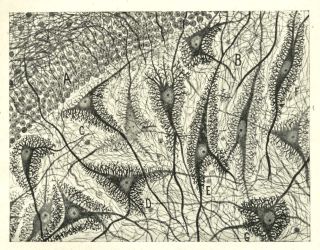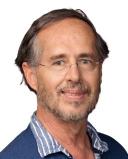Neuroscience
Santiago Ramón y Cajal and the Neuron Doctrine
A fiery, argumentative temperament paves the way to scientific breakthrough.
Posted February 25, 2023 Reviewed by Kaja Perina
Key points
- The decades-long debate between Nobelists Santiago Ramón y Cajal and Camillo Golgi can be seen as giving birth to the field of neuroscience.
- In understanding their struggle it can be helpful to look at possible contributions of their personalities as well as their scientific findings.
- Cajal was influenced by a fascination with exploration, as well as anti-authoritarianism at school and home, and a proclivity for altercations.
- Cajal had the brilliance to see the possibilities of Golgi’s method, and to apply his artistic skills in the service of science.
In a previous post I described the life of Camillo Golgi, who in 1873 discovered a method for visualizing neurons in the microscope, and went on to develop a since-disproven theory that all the neurons in the brain are physically connected in one vast ‘reticulum.’ In summary, some years later, Santiago Ramón y Cajal, a decade younger, improved on Golgi’s technique and determined that neurons are contiguous, but not continuous, and communicate across the junctional gaps which were later named synapses.

The rivalry between these views climaxed when they jointly won the Nobel Prize in 1906, and devoted their Nobel lectures to lambasting each other. Ultimately the accumulation of data supported Cajal’s ‘neuron doctrine,’ leading to the birth of neuroscience as we know it. The previous blog was devoted to Golgi’s life, and in particular to how he refused to give up believing in his reticular theory for decades after the scientific community had left it behind. In this post we will look at Cajal, to understand what kind of person he was, and how his experiences and personality influenced his discoveries and role in the struggle with Golgi.
Cajal was born in 1852 to a family of impoverished farmers, in a village in northeastern Spain which was so remote that it could only be reached by foot or donkey, and whose inhabitants had apparently never seen a wheeled vehicle. His father, in order to better himself and marry the weaver’s daughter, apprenticed himself to a barber-surgeon, and the family moved from village to village, spurred on either by his efforts to gain an education or disputes about his compensation. Ultimately he qualified as a doctor, and in turn emphasized the importance of an education for his son. Santiago’s personality seemed poorly suited for schooling; he reacted poorly to authority, and was involved in fights and vandalism, leading to severe whippings and beatings by his father, whose repertoire may have included pain inflicted by tongs and the skills of a barber-surgeon.
At age 11 Santiago spent several days in jail after devising a cannon with which he destroyed a neighbor’s gate. Only two things seemed to offer hope. The first came about after he devised a scheme to cross rooftops to filch sweets from the home of a confectioner, and came across books of romantic adventure such as The Count of Monte Christo and The Three Musketeers. The second was his love for painting and drawing.
His father, now an instructor in anatomy, tried a number of stratagems, including apprenticing Santiago to a barber and a cobbler, and making him an assistant in the clinic, seemingly to no avail. The son's interests were elsewhere: he was writing and drawing pictures for a novel based on The Adventures of Robinson Crusoe. They finally found some rapport in an unlikely way, when the father took him to collect bones from the ossuary of a nearby cemetery; the two studied them at home, and the father developed respect for his his son's ability to draw them. Ultimately, he reluctantly enrolled in medical school, and graduated in 1873, the year that Camillo Golgi first published his new method of visualizing neurons.
Cajal briefly served in the Spanish military in Cuba, and came back ill after a medical discharge; he worked unsuccessfully and with little interest in his father’s clinic. Then in 1877 came the first of two events which were to change his life. He had traveled to Madrid to take his qualifying examinations, and while there visited the laboratory of Aureliano Maestre de San Juan, the leading Spanish histologist, where he discovered microscopy.
Cajal was quick to buy a microscope of his own with his military discharge money, and set up a laboratory in his father's attic. He had been floundering in his career, which now seemed to have a purpose. Microscopy opened up a world of discovery, perhaps like that of his childhood hero, Robinson Crusoe. He began to publish a series of papers under the title of ‘Marvels of Histology.’ In 1887 he again visited Madrid. This time he visited psychiatrist and histologist Luis Simarro Lacabra, who showed him among other things, slides of neurons stained with Golgi’s technique.
At this point the technique had been available for 14 years, but had attracted little interest, possibly because it was lost in the deluge of new methods, and initially had not been accompanied by illustrations. It also was considered to have inconsistent results which were dependent on a finicky preparation, and was seen almost as a curiosity. Cajal, however, saw the potential that had been overlooked by others. He returned to his laboratory, and improved on the method.
By 1888 he had visualized Purkinje cells in the cerebellum of pigeon embryos, surrounded by—but not touching—basket-like processes from stellate cells. He created drawings which were scientifically precise and at the same time had a kind of haunting beauty which in the years after his death led to a number of art museum exhibitions. He created his own journal to publish his results, printed 60 copies, and sent them to prominent scientists throughout Europe. He got virtually no responses. He continued his work, at the same time elaborating on his belief that neurons were not continuous with each other, and represented the basic anatomical and functional units of the nervous system.
In 1889 Cajal sent one of his papers to Golgi. At this point, Golgi was the chairman of the histology and pathology departments at the University of Pavia near Milan, and had not done work on neuronal tissue for several years. He replied by sending Cajal a paper on malaria, his current interest. Later Cajal wrote him, describing his viewpoint as ‘absurd’ and suggesting that Cajal visit him on the way back from a meeting in Berlin. When Cajal arrived, Golgi either was gone or did not respond.
As the years went on their engagement in the literature grew more and more contentious, but they were never to meet in person until they appeared in Stockholm as joint winners of the Nobel Prize, and attacked each other’s positions in their lectures. They never saw each other again. Golgi continued to distinguish himself in other areas of histology as well as administration and politics; as described in the previous post, he never deviated from his position about the nervous system as a reticulum, though the rest of the world had largely moved on to accept Cajal’s viewpoint. Cajal continued to write and to encourage his students, even on his deathbed in 1934. His final paper, written that year, was a detailed recapitulation of the neuron doctrine.
In looking back at Cajal’s life, then, one can see a number of personality qualities that led to his decades-long debate with Camillo Golgi. Among these were anti-authoritarianism and a tendency to get into altercations, which may have played out in his struggle with an older scientist who was the chairman of two departments, on track to become rector of his university. He had a remarkable dedication to microscopy which may partly have grown out of a youthful zeal for the romance of exploration, and the ability to express his findings through art. And finally, he had the ability to see what others had not—that Golgi’s method had contained the potential for visualizing and studying neurons—even though they came to very different conclusions about their function.
Portions of this article are adapted from The Battle over the Butterflies of the Soul: Camillo Golgi, Santiago Ramón y Cajal and the Birth of Neuroscience.




